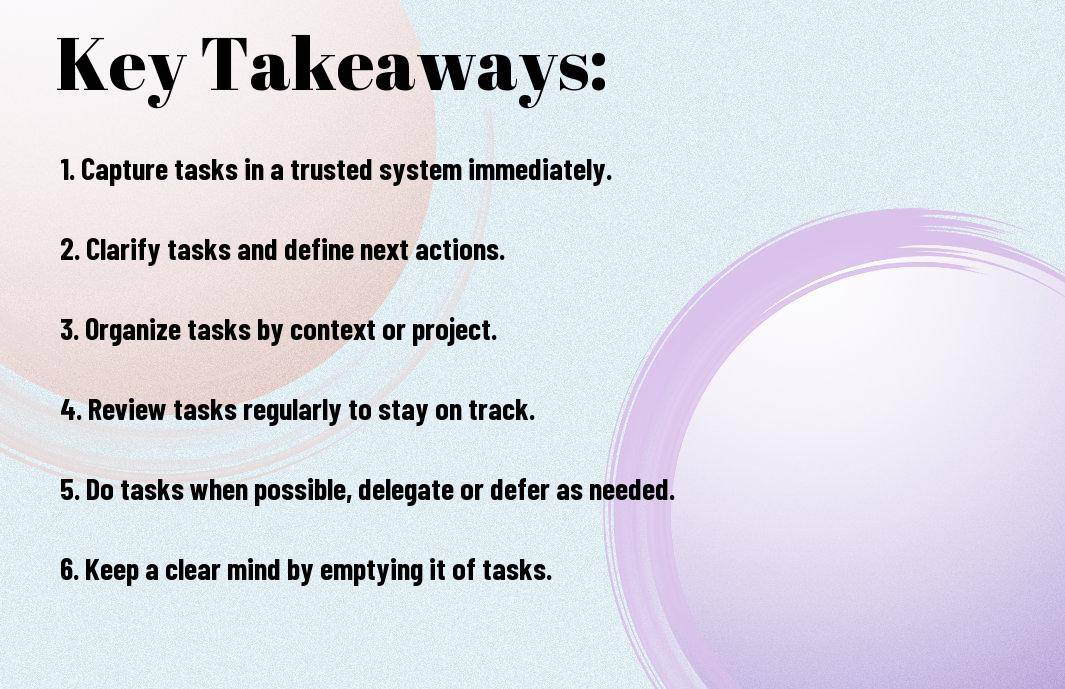
Newsletter Subscribe
Enter your email address below and subscribe to our newsletter

Enter your email address below and subscribe to our newsletter

Getting Things Done! It’s crucial in today’s fast-paced world to have a systematic approach to handle the ever-growing list of tasks and responsibilities. This is where David Allen’s Getting Things Done (GTD) methodology comes into play, offering a comprehensive framework to efficiently organize and prioritize tasks.


Assuming you’re familiar with the chaos that comes with a cluttered mind, the GTD philosophy offers a solution to achieve mental clarity and focus. With the ‘Mind-Like-Water’ concept, David Allen suggests that our minds should be clear, like a still pond, ready to respond to any disturbance with a calm and appropriate reaction. By capturing all tasks, ideas, and commitments in an external system, individuals can free up mental space and ensure nothing falls through the cracks.
For those looking to truly optimize their productivity, the GTD system introduces ‘The Five Stages of Mastering Workflow’. With structured steps like capturing all incoming tasks, clarifying what each one means, organizing them based on priority and context, reflecting on the next actions required, and engaging in the actual tasks at hand, individuals can streamline their workflow and enhance efficiency. By implementing these stages consistently, individuals can reduce stress, increase productivity, and ultimately achieve more in less time.
For instance, the ‘Organize’ stage encourages individuals to categorize tasks based on their context, such as tasks to be done at the office, calls to be made, or errands to run. This step helps individuals focus on tasks that are feasible within a given context, eliminating the need to sift through unrelated tasks and enhancing focus and efficiency.

For individuals looking to enhance their productivity, capturing all their ideas, tasks, and commitments is a crucial first step in the Getting Things Done (GTD) methodology. This process involves gathering all the information that has their attention, ensuring that nothing slips through the cracks. By capturing everything in a trusted system, one can free up mental space and focus on taking action efficiently.
For effective capturing, it’s necessary to leverage tools that seamlessly integrate into your workflow. Digital tools like Evernote, Todoist, or Trello are popular options that allow you to jot down ideas quickly, categorize tasks, and set reminders. For those who prefer a more tactile approach, traditional tools like notebooks or a physical inbox can also work well. Choose a tool that suits your preferences and ensures ease of use to capture information on the go.
Attention to detail is key when it comes to capturing tasks and ideas effectively. To ensure a comprehensive capture, set aside dedicated time each day to review your inboxes, whether digital or physical, and transfer any new items to your task management system. Consistency is crucial in maintaining an organized workflow, so make capturing a habit by incorporating it into your daily routine. By capturing all incoming information promptly, you avoid missing necessary tasks and stay on top of your commitments.
For instance, create specific capture buckets for different types of information, such as a “To-Do” list, “Waiting For” items, or “Someday/Maybe” ideas. This way, you can easily categorize and prioritize tasks based on their urgency and importance. Regularly reviewing and processing these capture buckets will help you keep track of all your commitments and ensure nothing gets overlooked.
Now that you have everything collected in your inbox, it’s time to start processing and clarifying each item. This step is crucial for effectively organizing and prioritizing your tasks using David Allen’s GTD system. You need to make decisions on what to do with each item based on a set of criteria to help you stay focused and productive.
On each item in your inbox, use the following criteria to determine the next action:
1. Is it actionable? If a task can be completed in two minutes or less, do it now. If not, decide whether to delegate, defer, or delete it.
2. Can it be delegated? If the task is better suited for someone else to do, forward it to the appropriate person with clear instructions.
3. Should it be deferred? If the task requires more time or resources, schedule it for a specific date or move it to a “waiting for” list.
4. Is it trash? If the item has no value or relevance, discard it immediately.
To efficiently clarify tasks, consider using techniques like mind mapping, categorizing tasks by context or project, and applying the “4 Ds” (Do, Delegate, Defer, Delete) method. These strategies help streamline the decision-making process and ensure that each task is handled appropriately.
To enhance your productivity, make sure to regularly review and update your clarified tasks based on changing priorities and deadlines. By consistently applying these techniques, you can effectively manage your workload and focus on completing tasks that align with your goals.
Decision: Applying the decision making criteria and techniques to clarify tasks in your inbox will help you efficiently organize and prioritize your workload, leading to better productivity and focus on important tasks.
Many individuals struggle with organizing their tasks effectively, leading to overwhelm and inefficiency. In David Allen’s GTD system, organizing tasks is a crucial step that helps bring clarity and structure to your workload.
With the GTD system, setting up a trusted system is crucial to ensure all your tasks are captured and managed efficiently. This system could be a digital tool, such as a task management app, or a physical tool, like a notebook. The key is to have a designated place where you can dump all your tasks and ideas so that your mind is free from constantly trying to remember everything.
Any effective organization system involves categorizing tasks based on their context, priority, and time sensitivity. By organizing tasks in this way, you can focus on what needs to be done at a particular moment, ensuring you make the most of your time and energy. This approach also helps in prioritizing tasks based on their importance and urgency, allowing you to tackle them systematically.
To organize tasks efficiently, create different categories such as ‘Home’, ‘Work’, ‘Errands’, ‘Calls’, etc., to group tasks based on where and when they can be completed. Assign priorities such as ‘Urgent’, ‘Important’, or ‘Low Priority’ to ensure you tackle high-priority tasks first. Additionally, allocate specific time slots in your schedule for tasks that need to be done at a particular time.

Unlike other productivity systems, GTD emphasizes the importance of reflection to keep your organizational system functional. Regular reviews are crucial to ensure that your tasks and projects are aligned with your goals and priorities.
Reflecting on your system allows you to identify any bottlenecks, missed deadlines, or tasks that may have slipped through the cracks. By regularly reviewing your projects and actions, you can proactively address any issues before they escalate.
Reflecting on a daily, weekly, and monthly basis is key to maintaining the efficiency of your GTD system. Daily reviews help you start each day with a clear focus, while weekly reviews allow you to adjust your priorities based on upcoming deadlines and commitments. Monthly reviews provide a bigger picture perspective, allowing you to assess your progress towards long-term goals.
Keeping your review sessions consistent and structured is crucial to staying on top of your tasks and projects. Set aside dedicated time for each review session and make sure to document any necessary changes or updates in your system.
Your journey in mastering the GTD methodology by David Allen leads you to the critical stage of engaging: executing the task at hand. Implementing your organized task list efficiently relies on making smart decisions based on context and available resources, as well as adopting a mindset centered around next-action thinking.
Choosing actions based on context and resources is crucial in ensuring productive task completion. When scanning through your action list, consider where you are, the tools at your disposal, and your mental and physical energy levels. Tailoring your actions to the environment and resources available can significantly enhance your efficiency and focus. For example, if you find yourself waiting in a doctor’s office with your smartphone, it might be an ideal time to respond to emails or draft a quick report.
Thinking in terms of next actions empowers you to make tangible progress on your tasks. Instead of overwhelming yourself with the entire project’s scope, breaking it down into small, actionable steps allows for a more manageable approach. By focusing on what needs to be done next, you eliminate ambiguity and procrastination, driving momentum towards completion. The key is to clearly define the very next physical action required to move the project forward.
To master the power of next-action thinking, consistently ask yourself, ‘What is the very next step I need to take to make progress?’ By identifying and prioritizing these actionable steps, you pave the way for steady advancement on your projects. Embracing this method shifts your focus from worrying about the bigger picture to effectively executing tasks one step at a time, leading to increased productivity and a sense of accomplishment.
Once again, let’s explore deeper into advanced strategies for implementing David Allen’s GTD system for efficient task management:
| To | leverage digital tools effectively in GTD, consider using task management apps like Todoist or Trello. These tools allow you to capture, organize, and prioritize tasks across various projects easily. |
| To | enhance your GTD workflow, integrate calendar apps like Google Calendar or Outlook with your task management tool to schedule tasks and set reminders for important deadlines. |
To effectively incorporate GTD principles into team and project management, consider using collaborative platforms such as Asana or Basecamp to delegate tasks, track progress, and ensure accountability among team members.
Digital tools can streamline communication and task assignment, making it easier for teams to collaborate efficiently and stay organized. By setting up shared project boards and assigning responsibilities within the GTD framework, teams can ensure that tasks are completed in a timely manner.
For instance, setting up recurring team meetings to review project tasks and deadlines can help keep everyone on track and address any bottlenecks or challenges that may arise. By incorporating GTD principles into team workflows, organizations can enhance productivity and achieve better results.
Procrastination is one of the major obstacles that can hinder your progress in following the GTD system. It often manifests as putting off important tasks, leading to a buildup of stress and anxiety. To tackle procrastination, it is important to break down tasks into smaller, manageable steps. By doing so, you can make the tasks seem less daunting and increase your motivation to get started. Additionally, setting clear deadlines and holding yourself accountable can help overcome the tendency to procrastinate.
Overwhelm can arise when there are too many tasks on your plate, causing difficulty in prioritizing and staying focused. To address overwhelm and maintain focus, it is crucial to regularly review your task list and identify the most important and urgent items. Utilize the GTD methodology of capturing, clarifying, organizing, and reviewing tasks to ensure you are allocating your time and energy to the right activities. Creating a daily routine and setting aside specific time blocks for different tasks can also help in maintaining focus and increasing productivity.
The key to overcoming procrastination and overwhelm is to implement strategies that work best for you personally. Experiment with different techniques, such as the Pomodoro technique for time management or the Eisenhower Matrix for task prioritization, to find what helps you stay on track and accomplish your goals efficiently.
All individuals deal with a multitude of tasks and responsibilities in their personal lives, ranging from household chores to family commitments. The GTD system can be incredibly beneficial in helping individuals effectively organize and prioritize these tasks. By capturing all incoming tasks into a trusted system, whether through a physical notebook or a digital app, individuals can ensure that nothing falls through the cracks. Processing, organizing, and reviewing tasks regularly can provide a sense of clarity and control, reducing feelings of overwhelm and stress.
The GTD system is particularly valuable for students and professionals who juggle various academic assignments, work projects, and deadlines on a daily basis. By utilizing the GTD methodology, students and professionals can break down complex projects into actionable steps, establish priorities, and maintain focus on what truly matters. The capture step ensures that no assignment or task is forgotten, while the regular review of next actions helps individuals stay on track and make progress towards their goals.
Personal productivity and efficiency can significantly improve when GTD principles are applied consistently. By implementing this system in everyday life, individuals can experience a sense of accomplishment, reduced stress, and increased confidence in their ability to manage tasks effectively.
After implementing the GTD methodology, many individuals find immense value in connecting with like-minded individuals who are also practicing GTD. The GTD community offers a platform for sharing insights, tips, and experiences to enhance personal productivity. Learning from GTD practitioners can provide new perspectives on how to apply the system effectively in different contexts and situations.
With the ever-evolving nature of work and life demands, it is crucial to stay updated on the best practices associated with GTD. Various resources are available to help individuals attain ongoing GTD mastery. These include books, podcasts, online forums, workshops, and training sessions. Resources for ongoing GTD mastery offer valuable insights and strategies to further refine organizational skills and productivity levels.
Understanding the importance of continuous learning and growth within the GTD community can significantly impact one’s ability to effectively manage tasks and projects. By tapping into the wealth of knowledge and resources available, individuals can enhance their GTD skills and stay ahead of the curve in today’s fast-paced world.
Considering all points, David Allen’s Getting Things Done (GTD) system provides a comprehensive and practical approach to efficiently organizing and prioritizing tasks. By breaking down tasks into actionable steps, setting up a trusted system for capturing ideas, and regularly reviewing and updating one’s lists, individuals can increase productivity and reduce stress. For a more in-depth guide on how to implement GTD effectively, check out The Complete Guide to Getting Things Done (GTD) on Asian Efficiency.
A: Getting Things Done (GTD) is a time management method and productivity system created by David Allen, aimed at helping individuals organize and prioritize their tasks effectively.
A: GTD works by encouraging individuals to capture all their tasks, ideas, and commitments in an external system, break them down into actionable items, and organize them into specific categories for easy management.
A: The key principles of GTD include capturing all tasks and ideas, clarifying what each task entails, organizing tasks into actionable items, reviewing and updating task lists regularly, and engaging in tasks based on priority and context.
A: GTD can improve productivity by providing a systematic approach to managing tasks, reducing mental clutter, increasing focus on high-priority activities, and ensuring that nothing falls through the cracks.
A: The main components of the GTD system include collecting all tasks and ideas, processing tasks to determine next actions, organizing tasks into project lists and contexts, reviewing and updating task lists regularly, and engaging with tasks based on context and priority.
A: Yes, GTD is designed to be flexible and scalable, making it suitable for managing tasks and projects of all sizes and complexities, whether personal or professional.
A: To get started with GTD, individuals can begin by capturing all their tasks and ideas in a trusted system, processing tasks to determine next actions, organizing tasks into actionable lists, setting review routines, and consistently engaging with tasks based on priority and context.
Deep Work – Cal Newport’s Secrets to Maximizing Focus on Demanding Tasks
Biological Prime Time – Scheduling Tasks When Energy Is Highest for Peak Productivity
Eisenhower Matrix – Dwight D. Eisenhower’s Strategy to Prioritize Tasks by Urgency and Importance
80/20 Rule (Pareto Principle) – Vilfredo Pareto’s Technique to Focus on High-Yield Tasks
The 50/10 Rule – Managing Work and Break Times for Enhanced Productivity